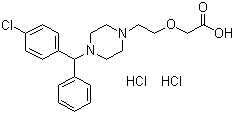Cetirizine hydrochloride CAS 83881-52-1 (jerryzhang001@chembj.com)
-
Post Date:
Apr 20,2017
-
Expiry Date:
Apr 20,2018
-
Detailed Description:
Cas No. :83881-52-1
Payment Method: T/T; Western Union; Moneygram and Bitcoin
Cetirizine hydrochloride CAS 83881-52-1
Product Name: Cetirizine hydrochloride;
Synonyms: (2-(4-((4-chlorophenyl)phenylmethyl)-1-piperazinyl)ethoxy)aceticaciddihydro;(2-(4-((4-chlorophenyl)phenylmethyl)-1-piperazinyl)ethoxy)-aceticacidihyd;ucb-p071;ZYRTEC;2-(2-{4-[(4-chlorophenyl)(phenyl)-methyl]piperazino}ethoxy)acetic acid dihydrochloride;AKOS 92015;CETIRIZIN DIHYDROCHLORIDE;CETIRIZINE 2HCL;
CAS: 83881-52-1;
MF: C21H26Cl2N2O3;
MW: 425.35;
EINECS: 222-225-5;
Product Categories: Active Pharmaceutical Ingredients;Intermediates & Fine Chemicals;Pharmaceuticals;Histamine receptor;Aromatics;Heterocycles;Metabolites & Impurities;API;Aromatics, Heterocycles, Metabolites & Impurities, Pharmaceuticals, Intermediates & Fine Chemicals;
Melting point: 110-115°C;
storage temp.: Desiccate at RT;
Description:
Cetirizine(trade names Zirtec, Zyrtec, Reactine, Triz) is a second-generation antihistamine used in the treatment of hay fever, allergies, angioedema, and urticaria. It is a major metabolite of hydroxyzine, and a racemic selective H1 receptor antagonist.
Second-generation antihistamines like cetirizine are less able to cross the blood-brain barrier and therefore have diminished effects on the central nervous system compared to first-generation drugs: for instance they are less likely to induce drowsiness or to interfere with memory formation.
Medical uses:
Allergies:
Cetirizine's primary indication is for hay fever and other allergies. Because the symptoms of itching and redness in these conditions are caused by histamine acting on the H1 receptor, blocking those receptors temporarily relieves those symptoms.
Cetirizine is also commonly prescribed to treat acute and (in particular cases) chronic urticaria, more efficiently than any other second-generation antihistamine;
Rhinovirus infection:
Interleukin 6 and interleukin 8 have been shown to be elevated in acute respiratory distress syndrome. Cetirizine contains L- and D-stereoisomers. Chemically, levocetirizine is the active L-enantiomer of cetirizine. One recent study of airway epithelial cells showed that levocetirizine may have beneficial effects on the pathophysiologic changes related to human rhinovirus (HRV) infection.
Kimura's disease:
Cetirizine is an effective agent in treating the symptoms of Kimura's disease which predominantly affects the lymph nodes and soft tissue of the head and neck in the form of tumor-like lesions. Cetirizine's properties of being effective both in the treatment of pruritus (itching) and as an anti-inflammatory agent make it suitable for the treatment of the pruritus associated with these lesions. In a 2005 study, the American College of Rheumatology conducted treatments initially using prednisone, followed by steroid dosages and azathioprine, omeprazole, and calcium and vitamin D supplements over the course of two years.
The skin condition of the patient began to improve and the skin lesions lessened. However, there were symptoms of cushingoid and hirsutism observed before the patient was removed from the courses of steroids and placed on 10 mg/day of cetirizine to prevent skin lesions; an agent suitable for the treatment of pruritus associated with such lesions. Asymptomatically, the patient's skin lesions disappeared after treatment with cetirizine, blood eosinophil counts became normal, corticosteroid effects were resolved, and a remission began within a period of two months. It is also thought that the inhibition of eosinophils may be the key to treatment of Kimura's disease due to the role of eosinophils, rather than other cells with regards to the lesions of the skin.
-
CAS Registry Number:
83881-52-1
-
Synonyms:
;Cetrizine Di-HCl;Cetirizine Hydrochloride;2-(2-{4-[(4-Chlorophenyl)(phenyl)-methyl]piperazino}ethoxy)acetic acid dihydrochloride;Cetrizine dihydrochloride;(2-{4-[(4-chlorophenyl)(phenyl)methyl]piperazin-1-yl}ethoxy)acetic acid dihydrochloride;Cetirizine Hcl;Cetirizine dihydrochloride;
-
Molecular Formula:
C21H27Cl3N2O3
-
Molecular Weight:
461.8097
-
Molecular Structure:

-
Company:
Nanjing Bangnuo Biotechnology Co., Ltd.
[ China ]
-
Contact:
Jerry Zhang
-
Tel:
86-25-52198306
-
Fax:
-
Email:
jerryzhang001@chembj.com
Inquiry
